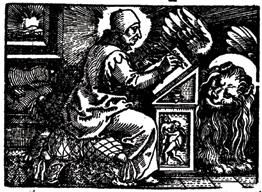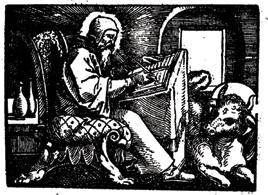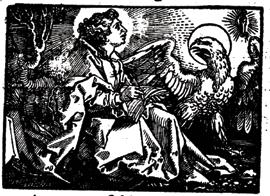
5 minute read
REFORMATION RESOURCES | “The Four
from The Evangel
REFORMATION RESOURCES
“The Four Evangelists” by Georg Aemelius Excerpted from Biblicae Historiae
translated by Casey Carmichael
Georg Aemelius—or Oemler in German—(1517–69) was a Lutheran theologian and botanist. His father was a friend of Hans and Margarethe Luder, Martin Luther’s parents. After studying theology at Wittenberg, Georg worked in school administration in various places throughout Germany. The following translation is a portion of his Biblicae Historiae, magno articifio dipictae, or A Beautifully Illustrated Biblical History, first published in Frankfurt in 1539. The portion translated here is of the four Gospels.
Matthew, who was conquered by love of wealth in a shameless way, Was a tax collector of people who passed by. Taking up the sweet commands of Christ who calls, He deserves to be a companion of eternal divinity. And when he had already seen very many miracles, God having been assumed through the high stars, He began to describe the descent of Christ with a pen, Who drew out genealogical trees from his own nation of Jesse. And running through the long origins of former kings, He enumerates the ancient grandfathers through a series. Hence the angel is added to him with shining wings. He sincerely composed a work on the blood of Christ. And since he teaches that Christ was begotten in a mortal body, He bears the face of a human body.
Mark the Evangelist I leave behind heavenly dogmas with rich words, And they sing Christ with a nobler tongue, Mark brings together immense labor with full brevity, And what sings in a confined space sings with the mouth. The lion gnashing its flashing teeth looks back, Writing of Christ, he foreshadows the kingdoms of power.
Mark asserts abridgments of the history of Christ, And with brief words he conveys very many deeds. Moreover, others sing these miracles with full cheeks, Conveying in a narrow space, he brought several objects together in his heart. Cheerful brevity is also useful for the reader, And has the name of elegant simplicity.
Mark takes up the acts of Christ in a short account, And the succinct little book has long deeds. Perhaps he thought what is brief to be more delightful, Hence he gave the acts of the Lord to be read with brief words. And since he conveys the miracles of the triumphant Christ, He has the royal sign of the lion victor.
Luke the Evangelist Luke began to depict Christ from tender childhood, And he preaches the acts of the infant of God. The bull lying down near him with winged body Bears the sign indicative of the virgin birth. This first fully bound fast to the manger in the stable, He saw the bodies of the one who was born as well as the mouths of God, And the inaccessible divinity, venerated under tender members, Pressed certain ground on bended knee.

Therefore, he adds this witness as aged antiquity, So that he proves with pleasure what he sings.
Luke makes mention of Christ being born in a very small cradle, And of the chaste virgin by miraculous act. The bull is added, on divinely bended knee, The wings hanging down, carried, which both circle. He, God, chaste with himself to the bearer from the womb. He, having become man by assuming a body, Is deserving of lying down at the stable full of heavenly assurance, A kneeling body presses the cold ground. Hence it is added to the poet who sings in the sacred cradle, So that the cow, which he sees, may testify to the work.
Since he paints the heavenly cradle so well with the thumb, You could call Luke a painter by right. What first was accustomed to give educated medicine to the sick, Expresses the infant God with the holy right hand, He thought to write heavenly gifts—a greater work— And to promote true riches in human matters. Christ brings this to all people with a most acceptable victim. He is portrayed by the sacred cow. He also saw the cradle of the Lord being born, So that we may believe those things, he is a witness.
John the Evangelist While he sings the eternal divinity with an elevated heart And God is born with the highest begetter, Lofty John is carried through the highest clouds And takes himself far from the mortal world. We see certain heavenly things flying through certainty, Birds, which rejoice in the bright light of the sun.

When he describes the life of the Lord and other public acts, Lest he relieve himself with a very serious beginning, John is raised into heaven where his mind has been carried, And remaining a long way off he sings of higher things, Namely that an inseparable divinity rules the world, Which is eternal and lacks an end and beginning. And as He was born with the supreme power of the most high father, God began to live in human flesh. He who lifting the harmful crimes of the experienced world Came under fatal suffering, as gentle as a lamb. When he opens such things with wings actively lifted high, He flies over the houses’ high ceilings and throughout the world. These blue eagles are lifted on high. It is clear where Apollo flashes in the bright world.
John, in the most pleasing care of the living Lord Carried in the lineage of the old house of Zebedee. Another enters, and abandoning earthly deeds, Sings high words about the threefold deity. This bird flies into the heavenly clouds with an exalted body, Carries the fiery lightning bolt above. This latter person was the one who writes heavenly words, And he was an exile of Patmos.

Casey Carmichael (ThD, University of Geneva) is the translator of the Commentary on the Epistle of St. Paul the Apostle to the Ephesians by Robert Rollock (1555–1599), recently published by Reformation Heritage.






